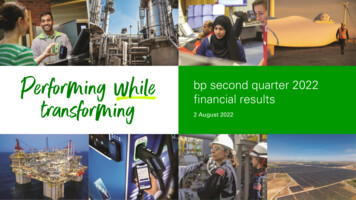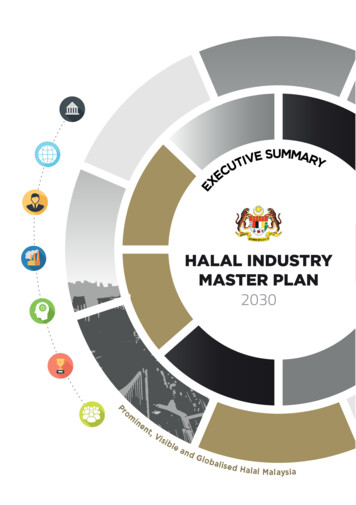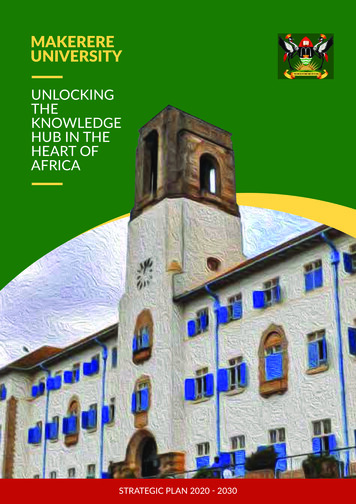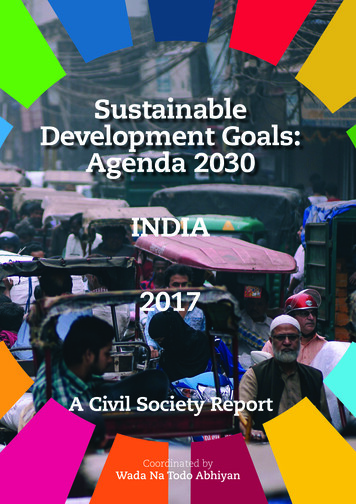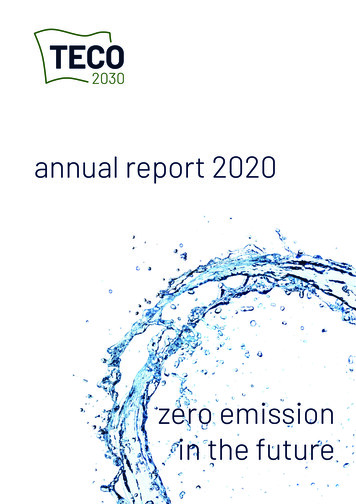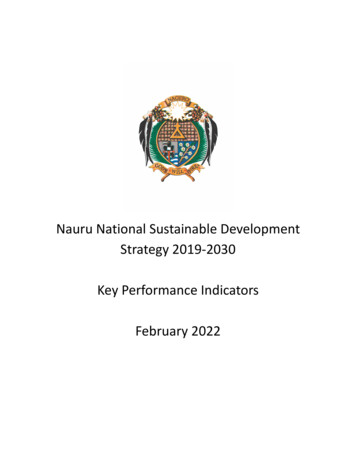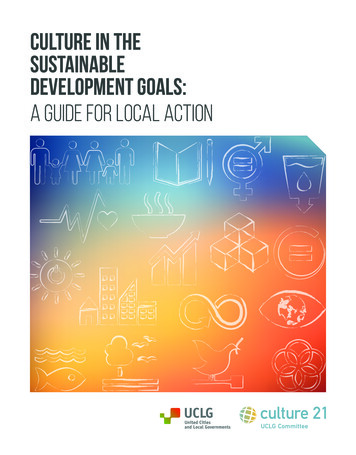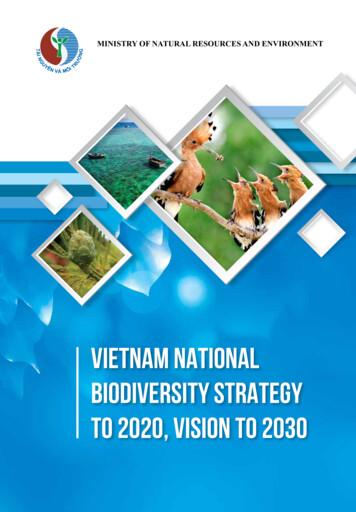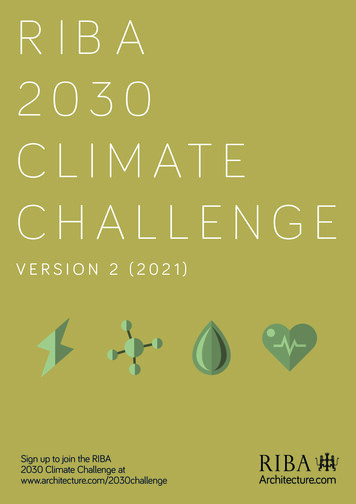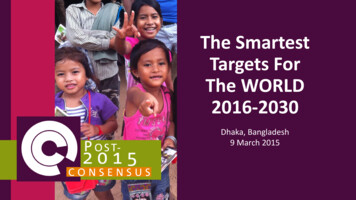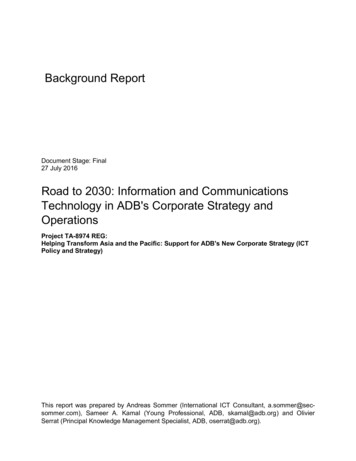
Transcription
Background ReportDocument Stage: Final27 July 2016Road to 2030: Information and CommunicationsTechnology in ADB's Corporate Strategy andOperationsProject TA-8974 REG:Helping Transform Asia and the Pacific: Support for ADB's New Corporate Strategy (ICTPolicy and Strategy)This report was prepared by Andreas Sommer (International ICT Consultant, a.sommer@secsommer.com), Sameer A. Kamal (Young Professional, ADB, skamal@adb.org) and OlivierSerrat (Principal Knowledge Management Specialist, ADB, oserrat@adb.org).
LIST OF ACRONYMS AND ABBREVIATIONS3rd generation mobile network–4th generation mobile network–5th generation mobile network–Asian Development Bank–Asian Development Fund–African Development Bank–Asia-Pacific Telecommunity–capital expenditure–Central and West Asia Regional Department–developing member country–East Asia Regional Department–European Commission–Economic and Social Commission for Asia and the Pacific–European Union–gigabits per second–gross domestic product–information and communications technology–information and communications technology for development–ICT Development Index–internet of things–information technology–intelligent transport systems–International Telecommunication Union–internet exchange point–least developed country–machine to machine–megabits per second–network operations center–Networked Readiness Index–operation and maintenance–Organisation for Economic Co-operation and Development–operational expenditure–public–private partnership–Pacific Department–People's Republic of China–quality of service–Radio-Frequency IDentification–SAP AG, German Software Company–South Asia Regional Department–Sustainable Development and Climate Change Department–Sustainable Development Goals–South East Asia Regional Department–small island developing state–technical assistance–universal service obligation–World Economic Forum–NOTEIn this report, " " refers to US dollars.
CONTENTSI.INFORMATION AND COMMUNICATIONS TECHNOLOGY IN ASIA ANDTHE PACIFIC . 1A.Current State of Information and Communications Technology inADB's Developing Member Countries . 1B.Upcoming Information and Communications Technologies andApplications . 5C.Recent and Upcoming Challenges in Information andCommunications Technology . 8II.OTHER DEVELOPMENT AGENCIES' INFORMATION ANDCOMMUNICATIONS TECHNOLOGY INITIATIVES. 11III.ADB'S INFORMATION AND COMMUNICATIONS TECHNOLOGYINITIATIVES AND LESSONS LEARNED . 14IV.FUTURE OPPORTUNITIES FOR ADB. 18V.A.Information and Communications Technology Policies andStrategies . 19B.Information and Communications Technology Infrastructure,Regulations and Skill-Building . 22C.Sector-Related E-Services and Applications . 24D.Case Studies . 28RECOMMENDATIONS. 34A.Strategic Options . 34B.Proposed Option: Gradual Scaling Up of Information andCommunications Technology Operations . 36C.Implications for ADB's Organization and Staffing. 39APPENDIXES1.2.3.4.5.6.Some Recent Trends in Information and Communications TechnologyThe Information and Communications Technology Ecosystem and Related IssuesSample Information and Communication Technology InitiativesSummary of Stakeholder Meetings at ADBPartnering for ICTRecommended Literature424456616364
BOXES, FIGURES, TABLESBox 1Box 2Box 3Box 4Box 5Box 6The Role of BroadbandPriority Areas for ADB in ICTCase Study on ICT Opportunities in IndonesiaCase Study on ICT Opportunities in the Pacific IslandsCase Study on ICT Opportunities in IndiaCase Study on ICT Opportunities in the PhilippinesFigure 1Figure 2Figure 3Figure 4Global Performance Overview: Networked Readiness IndexDevelopment of Global Trade, Finance, and Data (1980–2014)Breakdown of ADB's ICT-Related Projects by Sector (2000–2015)Breakdown of ADB's ICT-Related Financing by Sector (2000–2015)Figurre5Table 1Table 2Networked Readiness Index of Asian CountriesAverage GDP per Capita and Digital Adoption Index Values forDeveloping Member Countries and Global DatasetThe State of Broadband Infrastructure in Central Asian CountriesThe ICT Focus of other Development AgenciesNational Broadband PoliciesStrategic Options for ADB in ICTTable 3Table 4Table 5Table 6
EXECUTIVE SUMMARYInformation and Communications Technology in Asia and the PacificToday, information and communications technology (ICT) is increasingly a part of daily life and adriver of inclusive economic growth, social stability, and sustainable development. While the ICTsector in Asia and Pacific has seen unprecedented growth, particularly in terms of mobilecommunications in the Asian Development Bank (ADB's) developing member countries (DMCs),a significant portion of the population remains "offline", and developing Asia lags behind otherregions in terms of ICT policies and strategies, infrastructure, regulations, skills, and individualusage.While the private sector has and will invest in ICT infrastructure and services where there is astrong business case, public investment is required to ensure affordable access andconnectivity, particularly in remote and rural areas. DMC governments must also prepare for theimpact of upcoming ICT developments on the labor market, pursue reforms to bring greatercompetition to telecommunications markets, and promote public–private partnerships. Theserequire investing on the scale of billions of dollars in the years to come, and are likely to becomeincreasingly important as ADB’s DMCs move towards middle-income and upper middle-incomestatus.DMCs demand ICT to strengthen domestic sectors and keep pace with regional and globaldevelopment and competition. But, they face major challenges that include (i) building missinggaps in international, regional, and national backbone infrastructure; (ii) removing policy andregulatory restrictions on, for example, licensing and market entry, and promoting universalaccess to affordable broadband internet; (iii) enhancing ICT security and public awareness onsecurity; (iv) aggregating demand and scaling up e-services and applications; (v) building skillsand competitiveness; and (vi) promoting ICT for trade and regional integration.Opportunities for ADBBetween 2000 and 2015, ADB supported 402 ICT-related loan, grant, and technical assistance(TA) projects worth 11.91 billion, which is a mix of stand-alone ICT projects (8% of totalfinancing) and ICT-component projects (92%), and sovereign (89% of total financing) and nonsovereign (11%) financing. Among ADB management and staff, there is a clear recognition ofthe importance of ICT. However, there is a broad consensus that ADB is falling behind in thisarea, that it should do much more, and that a clear institutional support structure for ICT isneeded. There is also recognition that ADB may not be in a good position to gauge demand forICT, because ADB's ICT engagement has remained fragmented and largely focused on sectorrelated ICT.To date, ADB's engagements in ICT have been more opportunistic than strategic in nature. Incomparison, some other international financing institutions have had a more strategic andcoordinated focus on ICT.There is no doubt that ICT will play an increasingly important role in development, and inenabling the world to achieve the Sustainable Development Goals (SDGs). The needs of ADB'sDMCs in ICT, and thus opportunities for ADB, can be categorized in three priority areas: (i) ICTpolicies and strategies, (ii) ICT infrastructure, regulations, and skill building, and (iii) sectorrelated e-services and applications.ICT policies and strategies are the first successive priority for ICT development, and are aprerequisite for successful projects. A number of ADB's DMCs will need to develop or update
iitheir ICT policies and strategies in order to prepare and position themselves to take advantageof ICT-related opportunities now and in the coming years, which present opportunities for ADB.Strong growing demand for internet capacity requires regular upgrades of international andregional ICT infrastructure, including fixed line networks (e.g. fiber optic cables for submarineand backbone connectivity, and last mile connectivity), mobile networks (e.g. base stations andtelecom towers), satellites and data centers. ICT regulations, including standardization andsecurity, need to be implemented and regularly updated to keep pace with changingtechnologies and increasing globalization. ICT skill building and literacy, covering bothtechnicians and users, is also important, particularly as it pertains to data security andoperations and maintenance.There is also much space for ADB's support to sector-related e-services and applications,including turn-key solutions, to support sectors like education, energy, finance, health, transport,urban and water, and also governance and disaster risk management. By enhancingconnectivity within and across countries and regions, ICT is a critical part of the regionalcooperation and integration agenda. As a technology that can improve energy efficiency andreduce transportation-related costs, and also as a growing consumer of energy, ICT is alsoimportant for the climate change agenda.There are numerous opportunities for investments in ICT across ADB’s DMCs. Case studiesfrom Indonesia, India, the Pacific Islands, the Philippines, and other DMCs illustrate thedifferentiated and diverse needs of ADB’s DMCs, and highlight opportunities for ADB'sinvestment and intervention in the short and medium term. In Indonesia, ADB can considerinvestments to build on its TA for the preparation of the 23 billion Indonesia Broadband Plan(2014–2019). In India, ADB can explore investments in domestic connectivity (submarine cablesand telecommunications towers), smart cities, and entrepreneurship. In the Pacific islands, ADBcan continue to build on its ongoing engagement across the full spectrum of ICT, from strategyto infrastructure to sector-related e-services and applications. In the Philippines, the upcomingpreparation of an updated national broadband plan presents an opportunity for ADB to becomeinvolved at the planning stage and to identify future opportunities.RecommendationsLooking ahead to 2030, it is clear that there will be strong demand from DMCs for investments inICT. The question is how ADB will strategically position itself to respond. This paper proposes agradual, judicious scaling up of ADB's ICT operations, positioning ADB so it may develop areputation as a preferred partner for ICT in Asia, with a robust investment pipeline, in themedium to long term. This will be a natural extension of ADB's experience in ICT so far,including its successful engagements in the Pacific.Given its limited internal ICT technical skills and human resources, ADB's focus in the shortterm (2016–2017) should be on the most promising opportunities in countries where ADB hasgood on-the-ground knowledge and relationships. In such countries, ADB should supportupdating and formulating national broadband plans and strategies, where possible. ADB shouldalso take immediate steps to strengthen ICT components in sector operations, provide ICTtraining to staff, and further build its own experience in ICT procurement, ICT security, andcross-sector collaboration.In the medium term (2018–2019), an ICT sector group should be established. To date, ADB'sICT activities (encompassing loans, grants, TAs, and other support) have been organized andconducted through different parts of the institution, without a clear focal point. An ICT sectorgroup could be tasked with overall responsibility for preparing an ADB operational plan for ICT
iiiand supporting the operations departments in integrating ICT in sector strategies andoperations. Such a group would need to be dynamic, open and collaborative to be successful. Itis proposed that ADB successively and gradually build up this sector group, starting with therecruitment or teaming of 3–4 ICT experts, and building up further based on demonstrateddemand and success. In parallel, ADB should continue to recruit and work with consultants onspecialized topics, including through a dedicated expert pool, and through strategic partnerships.In the long term (2020–2030), ADB should be positioned as a recognized and noteddevelopment partner in ICT, with engagements and experience cutting across the ICT priorityareas. In the long term, to meet its suggested duties, responsibilities, and objectives, theproposed ICT sector group would have a diverse pool of 10–15 ICT experts (mostly in theoperations departments) whose experience and skills cut across all of the key areas in the ICTsector.
I.INFORMATION AND COMMUNICATIONS TECHNOLOGY IN ASIA AND THE PACIFICA.Current State of Information and Communications Technology in ADB'sDeveloping Member Countries1.Information and communications technology (ICT) is increasingly part of daily lifeand a driver of inclusive economic growth, social stability, and sustainable development.ICT has no borders between countries, regions, cultures, and sectors. It is global and crosssectoral. Increased access to ICT, particularly high-speed internet services (broadband), helpsto deliver improved financial services, as well as social services, such as health and education. Itbrings efficiency and reduces the cost of these services, and in turn enables an environmentconducive to private sector investment. Moreover, ICT has creates or enables significantemployment opportunities for both women and men in many countries around the world byenabling firms to access an increasingly global client base.2.The basis for ICT is connectivity through high-speed internet access (broadband).1Broadband connectivity accelerates economic growth, improves labor productivity, creates jobopportunities, enhances quality of life, and reduces energy consumption and greenhouse gasemissions. A number of recent studies have considered the role of broadband in the economy,as well as its social and economic impacts. These are summarized in Box 1 below.Box 1: The Role of Broadband Every 10% increase in broadband penetration accelerates economic growth by 1.38% indeveloping countries and 1.12% in developed countries.a 10% higher broadband penetration in a specific year correlates to 1.5% greater labor productivitygrowth over the following 5 years.b Countries with higher internet penetration reap up to 25% more benefit from cross-border dataflows than those with limited internet penetration.c There is a disparity between male and female internet users. Bringing 600 million more womenonline could increase global gross domestic product (GDP) by 12–18 billion. d Digitization can boost productivity, create jobs, and enhance quality of life. If emerging marketscould double the digitization index score for their poorest citizens over the next 10 years, theresult would be a global 4.4 trillion gain in nominal GDP, an extra 930 billion in the cumulativehousehold income for the poorest, and 64 million new jobs for today's socially and economicallymost marginal groups. b The use of broadband can reduce greenhouse gas emissions by up to 25%. Mobile technologycould lower greenhouse gas emissions by 2% by 2020. d E-commerce could lower energy consumption by 30% over traditional retails. daThe World Bank. 2016. World Development Report 2016: Digital Dividends. www.worldbank.org/en/publication/wdr2016bBooz & Company. 2009. Digital Highways The Role of Government In 21st-Century a/file/Digital Highways Role of Government.pdfcMcKinsey & Company. 2016. Digital Globalization: The New Era of Global Flows. www.mckinsey.com/mgidBroadband Commission for Digital Development. 2012. The Broadband Bridge: Linking ICT with ClimateAction for a Low-Carbon Economy. /BD-bbcommclimate.pdf3.Currently, only about 40% of the world's population has access to basic (slow)internet, while only 15% has affordable access to broadband (high-speed) internet. Use ofmobile phones, reaching almost three-quarters of the world's population, provides the main formof internet access in developing countries. But the lives of more than 2 billion people remain1High-speed internet (broadband) includes the total number of fixed-line broadband subscriptions (such as DSL,cable modems, fiber optics), and the total number of 4G/LTE mobile subscriptions, minus a correcting factor toallow for those who have both types of access. 4G fourth-generation, DSL digital subscriber line, ICT information and communications technology, LTE Long Term Evolution.
2largely untouched by ICTs, and half a billion live outside of areas with a mobile signal. Asiancountries with large offline populations include India (1,063 billion), People's Republic of China(PRC) (755 million), Indonesia (213 million), Pakistan (165 million), Bangladesh (148 million), thePhilippines (63 million), Myanmar (53 million), Vietnam (52 million), and Thailand (48 million).2 InOECD countries, fixed-line networks came first, and now form the backbone for internet access.But most developing countries jumped straight to mobile networks without investing first in fixedline backbone connectivity. The consequence for many users in developing countries is aninternet that is slow, expensive, and rarely "always on." For example, a 2014 survey by theIndonesian mobile operator Indosat Ooredoo found that 91% of young Indonesians said they didnot spend as much time online as they would have liked, due to poor connectivity. 3 ThePhilippines, including its capital Manila, has one of the slowest average broadband speeds inAsia and in the world.44.While timely and reliable global analyses relating to ICT is difficult, because of thefast-moving nature of the sector, some recent analyses give an indication of how ADB'sdeveloping member countries (DMCs) perform relative to other countries. For example, theWorld Economic Forum (WEF) Networked Readiness Index (NRI) provides a snapshot of ICTdevelopment including market conditions and the state of connectivity in different countries.5 TheDigital Adoption Index, a metric developed by the World Bank as part of its 2016 WorldDevelopment Report titled "Digital Dividends," attempts to benchmark digital adoption bybusiness, governments, and people across 130 countries globally.6 While countries' positions onsuch indexes can vary significantly from year-to-year, they help to provide a snapshot of ICTdevelopment in a given year or before.5.With a few exceptions, ADB DMCs rank in the bottom 55% in terms of networkedreadiness.7 Table 1 below shows the ranking and NRI of Asian countries for 2015 and 2010,relative to 143 (2015) and 139 (2010) economies around the globe. NRI values are measured ona 1 (low) to 7 (high) scale and are based on four sub-indexes (and 10 pillars):(i)(ii)(iii)(iv)234567environment sub-index (pillars: political and regulatory, business and innovation);readiness sub-index (pillars: infrastructure, affordability, skills);usage sub-index (pillars: individual, business, government); andimpact sub-index (pillars: economic, social).The World Bank. 2016. World Development Report 2016: Digital Dividends. http://www.worldbank.org/en/publication/wdr2016L. Cosseboom. 2014. Indonesian Government Launches High-Speed Internet Initiative. gh-speed-internet-2014-2019-broadband-planndY. Gonzales. 2015. PH Internet 2Slowest in Asia One of the Most Expensive. pensiveThe World Economic Forum (WEF): "The Global Information Technology Report 2015 - ICTs for InclusiveGrowth", 2015. http://www3.weforum.org/docs/WEF Global IT Report 2015.pdfThe World Economic Forum (WEF): "The Global Information Technology Report 2010-2011 – Transformations2.0", 2011. http://www3.weforum.org/docs/WEF GITR Report 2011.pdfWorld Economic Forum. 2015. The Global Information Technology Report 2015: ICTs for Inclusive Growth. 2015.http://www3.weforum.org/docs/WEF Global IT Report 2015.pdfThese exceptions are: Singapore; Japan; the Republic of Korea; Hong Kong, China; Taipei,China; Malaysia; andthe PRC.
3Table 1: Networked Readiness Index of Asian CountriesPlaceCountry2015 (2010)Singapore1 (2)Japan10 (19)Korea12 (10)Hong Kong, China14 (12)Australia16 (17)New Zealand17 (18)Taipei,China18 (6)Malaysia32 (28)China, People’s Republic of62 (36)Sri Lanka65 (66)Thailand67 (59)Philippines76 (59)Indonesia79 (53)Viet Nam85 (55)Bhutan88 (-)India89 (48)Lao People’s Democratic Republic97 (-)Kyrgyz Republic98 (116)Bangladesh109 (115)Cambodia110 (111)Pakistan112 (88)Tajikistan117 (112)Nepal118 (131)Timor-Leste134 (136)Myanmar139 93.93.73.73.63.53.33.33.33.23.22.82.5Note: Other Asian and Pacific countries were not considered in the Network Readiness Index, because nodata was availableSource: World Economic Forum. 2015. The Global Information Technology Report 2015: ICTs for InclusiveGrowth. 2015. http://www3.weforum.org/docs/WEF Global IT Report 2015.pdf6.Relative to other regions, emerging and developing Asia lags behind in manydimensions of ICT, and particularly in terms of infrastructure, skills, and individualusage.8 Figure 1 illustrates the performance of different regions in terms of NRI, and alsohighlights global best and worst performing countries, across its ten pillars. It is worth noting thatcountries in both emerging and developing Asia (which would include most DMCs in ADB’s EastAsia, Southeast Asia, and South Asia regions) and the Commonwealth of Independent States(which would include most DMCs in ADB’s Central and West Asia region) compare morefavorably relative to other developing regions in terms of affordability, business usage andgovernment usage. Even though internet access is generally affordable and well-utilized bybusinesses and governments in some of ADB’s DMCs, significant investments are still neededto improve ICT infrastructure in line with policies and regulations, skills, and use by individuals.8For the NRI, "Emerging and developing Asia" includes most DMCs in ADB’s East Asia, Southwest Asia and SouthAsia regions. Central and West Asia DMCs are largely covered under the Commonwealth of Independent States.Most Pacific countries were not assessed as part of the NRI.
4Figure 1: Global Performance Overview: Networked Readiness IndexSource: The World Economic Forum (WEF): "The Global Information Technology Report 2015—ICTs for InclusiveGrowth", 20157.Adoption of digital technologies by citizens in ADB's DMCs may be less than inother parts of the world. A quick analysis of a subset of the 18 ADB DMCs9 out of the total of130 countries considered and indexed in the World Bank's 2016 Digital Adoption Index issummarized in Table 2.10 The results should be seen as indicative. The lower values for theDigital Adoption Index for citizens are consistent with the low scores for the region in NRI's pillaron individual usage and on ICT skills. Meanwhile, digital adoption of business and governmentsin ADB DMCs appears to be more consistent with global trends, the same trend suggested bythe NRI's pillars on business usage and government usage.Table 2: Average GDP per Capita and Digital Adoption Index Values for Developing MemberCountries and Global DatasetGDP per CapitaDigital Adoption Index(constant 2005 390.560.67(130 countries)DMC Average(18 countries)4,1060.340.550.57Source: World Bank 2016. World Development Report 2016: Digital Dividends.910Armenia, Bangladesh, Brunei Darussalam, Cambodia, the PRC, India, Indonesia, the Republic of Korea, the LaoPDR, Malaysia, Myanmar, Nepal, Pakistan, the Philippines, Sri Lanka, Tajikistan, Thailand, Uzbekistan, andVietnam.The World Bank. 2016. World Development Report 2016: Digital Dividends. http://www.worldbank.org/en/publication/wdr2016
58.Many of ADB's DMCs cannot keep pace with global ICT development and regionalintegration due to a lack of investments in and attention to (i) ICT policies and strategies;(ii) ICT infrastructure; (iii) ICT regulations and standardization (including ICT security);(iv) ICT skills development; and (v) e-services and applications. Generally speaking, thesekey areas, which are listed in successive order from more "upstream" investments to more"downstream" investments, must be addressed successively in order to develop ICT and unlockits development potential.9.Each country's situation is different and unique, and must be consideredindividually based on actual available data. For example, Table 3 below shows how keymeasures of the state of a country's ICT development, such as broadband infrastructure,affordability, and competitiveness of telecommunications markets, vary across selectedcountries in the Central and West Asia region.11 Two countries in the same region and withsimilar per capita gross domestic products (GDPs), such as Azerbaijan and Turkmenistan, canhave significant differences in terms of the level of their broadband infrastructure development,international bandwidth per capita, and competitiveness of telecommunications markets.Annual1 MbpsBroadbandSubscription Installationas % of Nominal GDPper CapitaFixed and MobileBroadbandInfrastructureCompetitiveness ofTelecom MarketDomesticConnectivityIP Transit PriceInternationalConnectivityInternational BandwidthPer Capita (Kbps)GDP per Capita, YearEnd 2012 ( )Table 3: The State of Broadband Infrastructure in Central Asian CountriesAzerbaijan 10,80022.4ModerateAdequateReasonably eKazakhstan 14,00016.5Moderate StrongLimitedTajikistan e Competitive LimitedExpensiveTurkmenistan 9,6000.125WeakLimitedVeryNotVeryVeryExpensive Competitive LimitedExpensiveUzbekistan ive CompetitiveExpensiveSource: ESCAP: "An In-Depth Study of Broadband Infrastructure in North and Central Asia", January 2014.B.Upcoming Information and Communications Technologies and Applications10.The world has never been more deeply connected by commerce, communication,and travel than it is today. However, the pattern of globalization is shifting. Trade was oncedominated by tangible goods and was largely confined to advanced economies and their largemultinational companies. Today, global data flows are surging, while digital platforms allow morecountries and smaller enterprises to participate in the global economy.12 This allows firms toenter new markets, reduce transaction and communication costs, and improve business1112United Nations Economic and Social Commission for Asia and the Pacific. 2014. An In-Depth Study of BroadbandInfrastructure in North and Central Asia. band-infrastructurenorth-and-central-asiaJ. Manyika et al. 2016. Digital Globalization: The New Area of Global Flows. McKinsey Global GI Digital globalization Full report March 2016.pdf
6efficiency, ultimately contributing to inclusive economic growth. As shown in Figure 2, globaldata flows are soaring while global flows of trade and finance are flattening.Figure 2: Development of Global Trade, Finance, and Data (1980–2014)Source: McKinsey Global Institute: "Digital Globalization: The New Area of Global Flows", March 2016.11.There are two key trends in upcoming ICT technologies that will have a significantimpact on the development of countries globally, including ADB's DMCs. These are 5Gmobile networks and the internet of things (IoT).1312.From 2020 onwards 5G mobile networks will provide a major boost in global ICTdevelopment. At present, peak speeds of 4G mobile networks are at 150 Mbps, 5G will becapable of transmitting data 100 times faster at up to 20 Gbps. It is expected that 5G mobilenetworks will become a multi-billion dollar business around the globe with new businessopportunities for network infrastructure, devices, services, applications and gadgets.14 Given thatmobile communication are the main source of connectivity in many DMCs, the development of5G mobile networks will bring significant opportunities for their people, businesses, andgovernments.13.Recent estimates from McKinsey & Company suggest that the IoT has a totalpotential economic impact of 3.9 trillion to 11.1 trillion a year by 2025.15 At the top end,that level of value, including the consumer surplus, would be equivalent to abou
Document Stage: Final . 27 July 2016 . Road to 2030: Information and Communications Technology in ADB's Corporate Strategy and Operations. Project TA-8974 REG: Helping Transform Asia and the Pacific: Support for ADB's New Corporate Strategy (ICT Policy and Strategy) This report was prepared by Andreas Sommer (International ICT Consultant, a .
